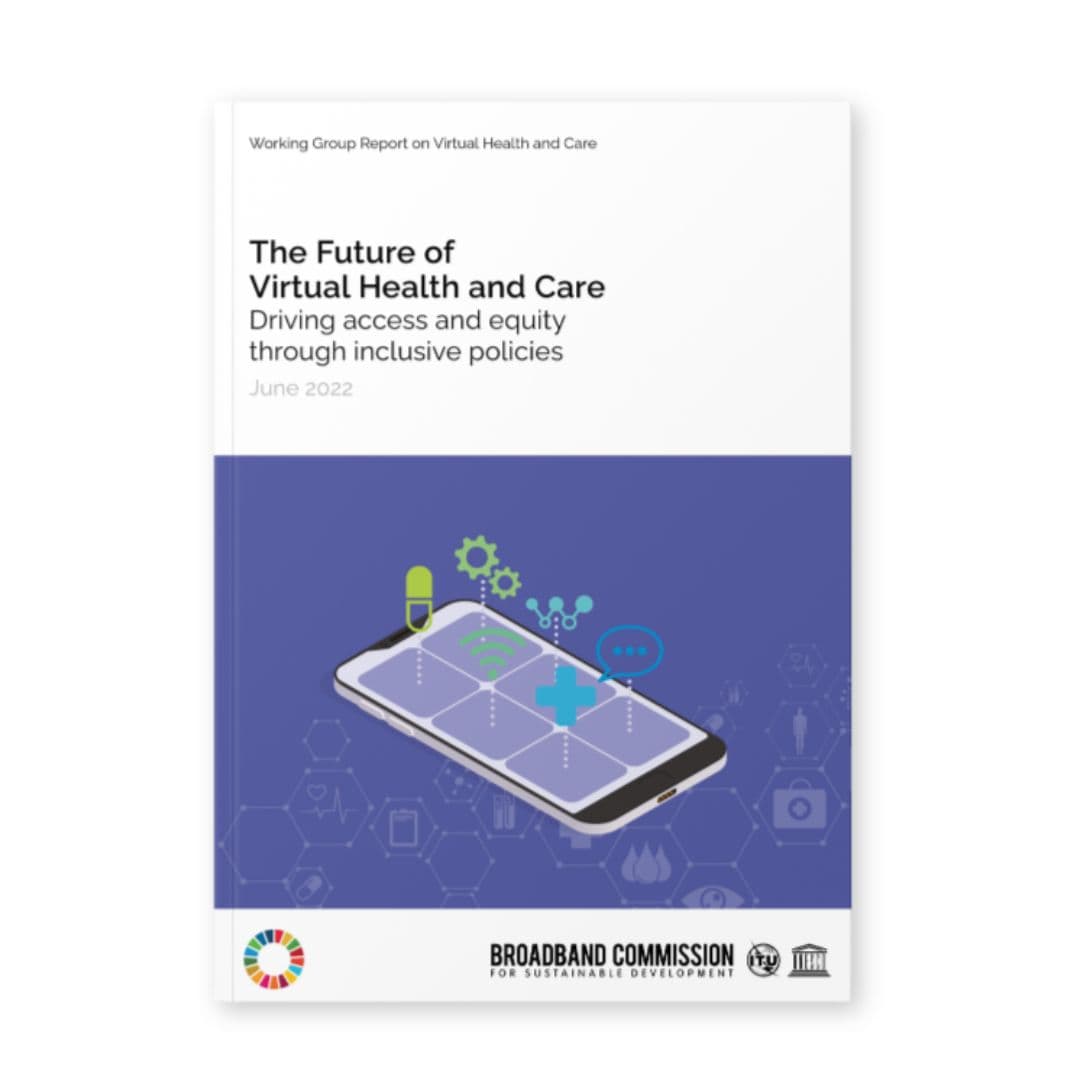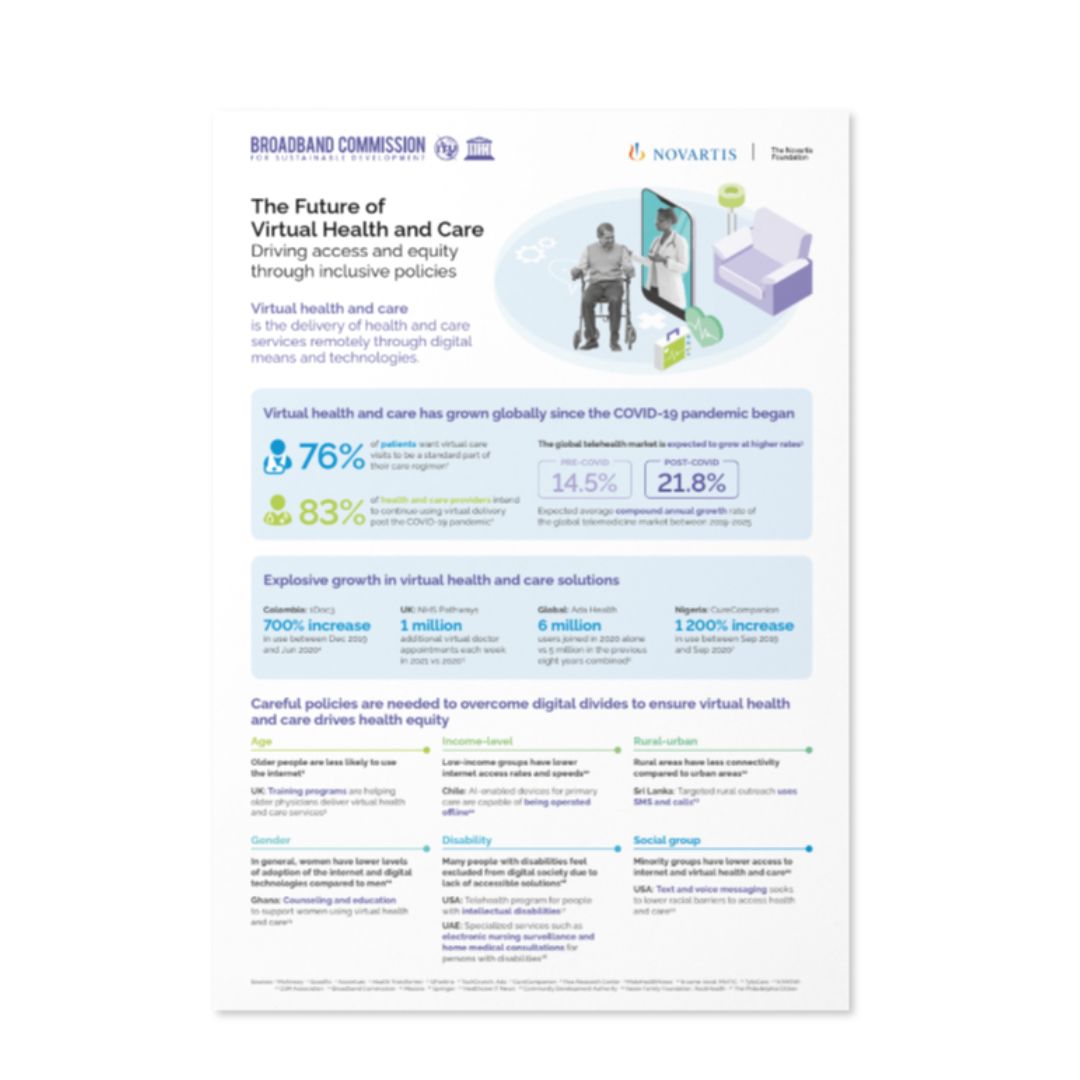How can we ensure virtual health and care is accessible to all, drives health equity, and is fully integrated into physical health and care systems?
The Broadband Commission Working Group on Virtual Health and Care was launched to examine virtual health and care in context of the COVID-19 pandemic: the trends, forecasts, key role of policy in influencing adoption, challenges, and ways of overcoming them. Co-chaired by Dr. Tedros Adhanom Ghebreyesus, Director General of the WHO, and Dr. Ann Aerts, Head of the Novartis Foundation, the Working Group’s 2022 report provides practical recommendations for the future of virtual health and care: how countries can achieve access and equity through inclusive policies.
Setting the Stage
Background Overview
The COVID-19 pandemic triggered a massive surge in virtual health and care delivery across the world, with many countries embracing hybrid virtual and in-person services. In the U.S., for example, the percentage of telehealth claims out of all health claims was 25 times higher in January 2022 compared to October 2019. In India, the numbers of synchronous teleconsultations on the national teleconsultation and e-outpatient service e-Sanjeevani were four times higher in February 2022 than in October 2020.
Virtual health and care has grown globally since the COVID-19 pandemic began
83%
of health and care providers intend to continue using virtual delivery post the COVID-19 pandemic
The global telehealth market is expected to grow at higher rates, with the expected average compound annual growth rate of the global telemedicine market between 2019-2015 up to 21.8%, from the pre-COVID 14.5% rate. But many countries have not yet developed coherent frameworks to ensure virtual health services work effectively alongside in-person care. Careful policymaking is essential to ensure that expansion of virtual services happens in an equitable and inclusive way, and existing digital divides do not exacerbate health inequities.
The Way Forward
Conclusions and Recommendations
Six key policy pillars for a virtual health and care policy maturity framework
Policymakers across the globe have an opportunity to maximize the opportunities offered by virtual health and care. But they need to do this in a way that builds equitable access to health.
The Working Group’s new framework for maturity in virtual health and care consists of the six policy pillars to build the hybrid physical-virtual health systems that countries need to overcome health equity and access challenges.
Governance and regulatory
Provide essential administrative and regulatory structure through strategies, plans, and guidelines.
Policy elements: governance, regulation, licensing, liability, quality assurance
Data and technology
Ensure the flow of data by blending hardware with evolving software and delivery standards.
Policy elements: infrastructure, data governance, interoperability
People and workforce
Equip different stakeholders with the required know-how through trainings, continuing education, skill upgrades, and competency building.
Policy element: digital skills building
Design and processes
Encourage user-friendly solutions by focusing on the individual through research and development and effective use of data in decision making.
Policy elements: human- and equity-centric, innovation, health outcomes
Business models
Supply financing and coverage through different funding sources, sustainable investments, and innovative pricing models.
Policy elements: financing, reimbursement
Partners and stakeholders
Bring together different players in the ecosystem through partnerships and teamwork.
Policy element: collaboration
But policymakers alone cannot advance virtual health and care in an inclusive way. It takes the collective actions of health and care providers, payers, private sector, advocacy groups, civil society, and researchers to complement policymaker actions and ensure effective policy development and implementation. The report therefore includes tailored calls to action for each of these groups.
Download the full report to learn more about the specific actions each group must take to overcome health equity and access challenges.
The Working Group Model
Composition and Activities
- Dr. Ann Aerts, The Novartis Foundation
- Dr. Tedros Adhanom Ghebreyesus, Dr. Soumya Swaminathan, WHO
- H.E. President Paula Kagame, Republic of Rwanda
- Mr. Houlin Zhao, ITU
- Ms. Audrey Azoulay, UNESCO
- Dr. Carlos Jarque, America Movil
- Mr. Amir Dossal, Global Partnerships Forum
- Dato’Ir (Dr) Lee Yee Cheong, ISTIC
- Dr. Qu Dongyu, FAO
- Mr. Robert Kirkpatrick, UN Global Pulse
- H.E. Ms. Aurélie Adam-Soule Zoumarou, Benin
- H.E. Dr. Amani Abou-Zeid, African Union Commission
- Mr. Rajeev Suri, Inmarsat Plc
- Mr. Bocar Ba, SAMENA Telecommunications Council
- Mr. Makhtar Diop, IFC
- Mr. Lacina Kone, Smart Africa
- Orange
- UNICEF
- UN-OHRLLS
- Ms. Isabelle Mauro, WEF
- Dr. Amandeep Gill, I-DAIR
- Mr. Dykki Settle, Ms. Skye Gilbert, PATH
- Dr. Ishrat Z. Husain, Ms. Adele Waugaman, USAID
- Dr. Joe Kvedar, Ms. Ann Mond Johnon, American Telemedicine Association
- Mr. Daniel Otzoy, Ms. Joseline Carias Galeano, Central American Health Informatics Network-RECAINSA
- Mr. Andres Martin, AXA
- Mr. Robert Metzke, Ms. Olesya Struk, Philips
- Dr. Alvin Marcelo, Mr. Jai Ganesh Udayasankaran, Asia eHealth & Information Network (AeHIN)
- Ms. Mathilde Forslund, Ms. Kirsten Mathieson, Transform Health
- Prof. Dr. Yunkap Kwankam, Mr. Frederic Lievens, ISFTeH
- Dr. Indira Joshi, NHSX (UK)
- Prof Dr. Antoine Geissbuhler, Prof. Dr. Cheick Oumar, Dr. Caroline Perrin-Franck, RAFT
- Mr. Siddharta Chaturvedi, Microsoft
The Group was launched during the Broadband Commission Virtual Annual Spring Meeting on March 22, 2021. It follows the successful on
The report was presented at the HealthTech Summit in the Norrsken East Africa House in Kigali, Rwanda on Saturday June 4 2022
Focus Area
Outcome Resources
Co-Chairs
Dr. Ann Aerts
Head, the Novartis Foundation
Dr. Tedros Adhanom Ghebreyesus,
Director General of the WHO
Broadband Advocacy Targets
SDGs









